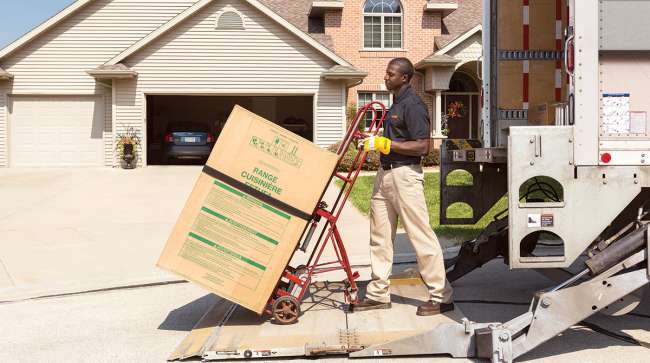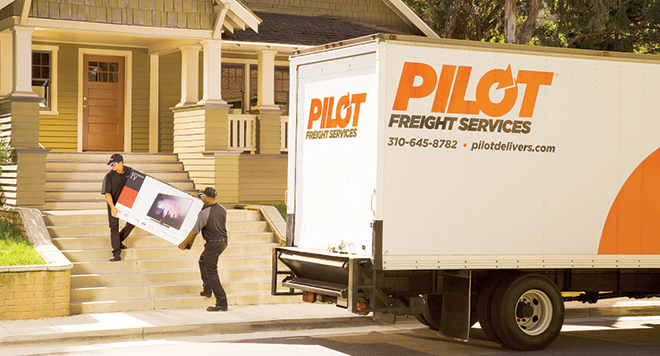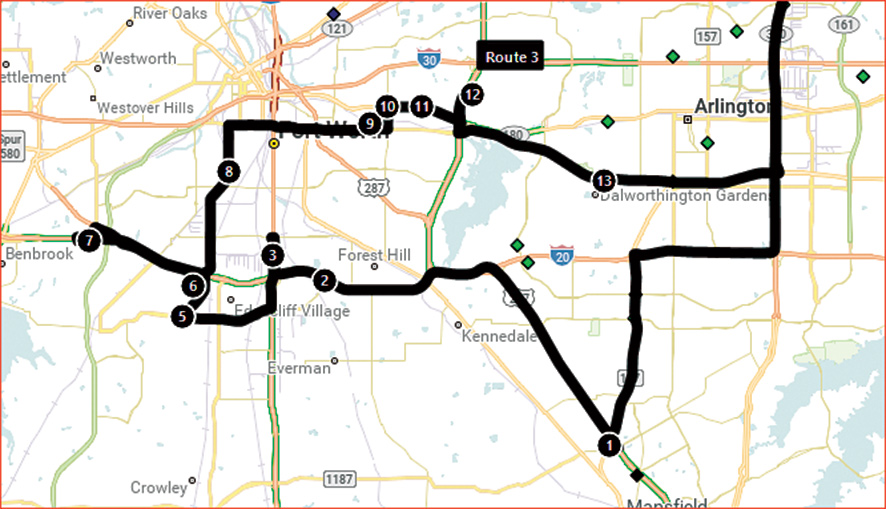Special to Transport Topics
Fleets Target Opportunities in Growing Final-Mile Sector

It was not so long ago that home delivery of products such as furniture, mattresses and televisions was straightforward and rigid, with few choices for customers.
That has changed dramatically with the rise of e-commerce, the influence of Amazon.com, the proliferation of smartphones, tablets and mobile apps and the ability to research, view, select and buy virtually any product online, from anywhere.
Delivery windows have shrunk — in some cases to the same day as the purchase — and now it is the retailer and its last-mile delivery provider who must adjust to the consumer’s schedule and meet higher expectations for visibility and flexibility.
2018 TT TOP 100 FOR-HIRE RANKINGS: See the new list
COMING JULY 18: LiveOnWeb's 'Reimagining Trucking'
This “final mile” delivery dynamic, once mostly an afterthought for retailers, today has become a strategic and integral part of a company’s customer service and brand reputation.
A growing number of carriers and logistics providers are stepping into the final-mile sector to help retailers meet these rising expectations.
One of the fastest growing areas for online sales has been in large products that require delivery and setup in the home.
According to Alix Partners’ March 2018 home-delivery shopping survey, online purchases of furniture, large electronics, mattresses and large appliances are rising rapidly as consumer reluctance to buying these products over an e-commerce platform diminishes.
For example, the number of respondents who have ever purchased furniture online climbed to 57% in 2018, from 33% in 2012. For large appliances, that figure jumped to 48% from 20% in the same time frame.

Pilot Freight Services offers home delivery of large-format goods, such as big-screen televisions. (Pilot Freight Services)
Jim Blaeser, director at Alix Partners, said one clear message from the survey is that providers of last-mile delivery services are becoming the face of the retailer.
The driver or delivery person must have “a level of presentability, customer service, product knowledge and communication skills, all oriented to the consumer,” he said, adding that these skills — including the ability to quickly and accurately assemble or install a product — are not necessarily inherent in the traditional truckload or less-than-truckload driver.
The rapid increase in online buying of large durable goods requiring last-mile delivery into the home is bringing new business opportunities for carriers. And thanks to e-commerce, it’s expected to continue to grow at a double-digit annual clip.
The challenge for trucking companies is how to address the market and develop the employee skills and management processes to be successful.
Strategies range from adapting current operations to service last-mile freight, launching new divisions, bolstering existing capabilities through acquisitions or buying current operators and then combining and building them into a national network through investments in facilities, technology and people.
In other cases, traditional LTL and parcel carriers are partnering with existing last-mile providers.
Five Keys to Success for Last-Mile Operators
It’s safe to say that consumer shopping behaviors will continue to evolve as people feel more comfortable buying large products online and require last-mile delivery and installation services.

Abeson
Jeff Abeson, chief commercial officer of Ryder Last Mile Solutions, shares his view on the five keys to success for a last-mile delivery provider:
1. Continue to invest in technology that puts more control of the customer experience in the consumer’s hands, such as self-service tools.
2. Relentless focus on customer centricity with the end goal of 100% customer satisfaction.
3. Provide a multitude of offerings that can support customers with different supply chain needs. Business models change and companies grow. Be a partner that’s agile and nimble enough to meet your customer’s long-term needs.
4. Have a national presence so that you can be the catalyst of growth for customers and offer them national distribution without the added cost of the necessary infrastructure.
5. Develop a collaborative relationship with your customers so you are better positioned to receive accurate forecasting, which is critical to operational success.
Schneider has been in the last-mile business in one form or another for a decade. The fleet operates 32 warehousing and cross-dock facilities in urban areas that serve as hubs for last-mile deliveries. It provides business-to-business and business-to-consumer deliveries of large goods ordered online.
“With the onslaught of e-commerce and the transformation of the retail supply chain, we’ve been amping up the focus [on last mile],” Chief Operating Officer Mark Rourke said.
In mid-2016, Schneider bolstered its capabilities by acquiring an LTL carrier that specialized in the furniture and flooring business, and a technology company that provided last-mile delivery planning and operating software connecting retailers, delivery agents, third parties and customers. The acquisitions have been integrated with existing Schneider resources into a full-scope last-mile offering, which today services many retailers and e-tailers and handles many types of large-format goods.
“We are first-to-final mile,” Rourke said. “We pick up at the vendor and then deliver to the end consumer. Our strategy is to knit all that together in a seamless experience for the consumer and the retailer.”
He added that customers purchase services ranging from curbside delivery to white-glove services that include assembly or installation in the consumer’s home.
While Schneider emphasizes company drivers and company-owned equipment for consistency of service, the fleet deploys a blended model, which also includes vetted, qualified and experienced agents.
“We’ll always use some level of third-party provider to supplement the network,” Rourke said.
The Green Bay, Wis.-based carrier ranks No. 7 on the Transport Topics Top 100 list of the largest for-hire carriers in North America.
Ryder System Inc. also has employed an acquisition strategy.
Earlier this year, the company completed a $120 million purchase of MXD Group, an e-commerce fulfillment provider with a national network of facilities and last-mile capabilities.
Ryder said the acquisition positioned it as the second-largest last-mile delivery provider of big and bulky goods. Ryder’s network includes 112 e-commerce hubs covering all of the United States and 70% of Canada for home delivery and white-glove service.
“The final mile into a customer’s home is the most difficult piece of a supply chain,” said Jeff Abeson, chief commercial officer of Ryder Last Mile Solutions. “Having the back-end technology, visibility and customer care systems to satisfy the customer’s requirement are becoming table stakes.”
He noted that retailers want a seamless solution for in-home delivery, on a national basis, with the right balance of speed and cost.
Today’s consumers, he added, “want their goods exponentially faster. The key is to be as close to the end consumer as possible, and our network breadth achieves that for us.”

Fleet routing and tracking software can provide real-time shipment visibility for final-mile operations. (TMW Systems)
XPO Logistics also has established itself as a major player in the final-mile delivery sector.
The company has placed a strong emphasis on connecting its LTL service with its expanding network of final-mile hubs.
XPO, based in Greenwich, Conn., ranks No. 3 on the for-hire TT100.
Werner Enterprises last year launched Werner Last Mile as its entry into the market.
The new service primarily focuses on delivering “large or heavy items using two uniformed associates operating a liftgate straight truck,” the company said.
The Werner Last Mile network operates from nearly 200 locations, supporting e-commerce shipments with white-glove home and business deliveries including returns and exchanges.
Werner, based in Omaha, Neb., ranks No. 15.
Unlike a traditional LTL network, which requires major investments in physical infrastructure and rolling stock, the hurdles to entry in the last-mile segment are not as overwhelming.
Thousands of agents, contractors and owner-operators with small fleets of commercial vans and straight trucks are operating in the market. Many of these operators contract directly with smaller retailers for local or regional deliveries or align themselves with national last-mile networks.
“The real barrier to entry into this space is commitment and a culture of customer centricity,” said George Balle, a vice president with Lima, Pa.-based Pilot Freight Services, which has invested in a full-scale home-delivery solution for large-format goods.
While many carriers and forwarders have entered the last-mile home delivery market, “few have hit the mark” that e-commerce retailers are looking for, he said.
Price and speed tend to drive consumers’ buying decisions, meaning that carriers must operate within specific delivery windows.
“Your driver team … must enter the home and perform in a professional and courteous manner,” Balle added. “Not everyone is ready for, or interested in, the level of training and culture shift that is required.”
Brian Bourke, vice president of marketing for Itasca, Ill.-based Seko Logistics, divides last-mile players into three buckets: LTL fleets, van lines and moving companies; forwarders and third-party logistics providers; and integrators, courier companies and startups.

Bourke
Seko, a third-party logistics provider, offers last-mile, white-glove home delivery services from some 60 North American locations using specialized Seko-branded vehicles and trained, certified drivers and installers.
As e-commerce continues to represent an ever-growing percentage of a retailer’s sales, the choice of a last-mile delivery partner becomes even more of a strategic decision.
“It’s an extension of [the retailer’s] brand,” Bourke said. “Your brand reputation is wholly dependent on [the performance of] that third party. It’s critical to pick the right partner.”
Over approximately a decade, J.B. Hunt has built its final-mile service into a large nationwide network with 92 locations, more than 1 million square feet of warehouse space and coverage throughout the United States.
In 2017, it acquired Special Logistics Dedicated, expanding its resources and service offerings.
“Online sales of big and bulky items continue to grow,” said Nick Hobbs, J.B. Hunt executive vice president and president of the company’s Dedicated Contract Services unit. “The supply chain in the final-mile space has had to evolve to meet demand.”

J.B. Hunt Transport Services Inc.
Hobbs echoed a viewpoint held by many last-mile providers.
“We are a brand ambassador for the retailers and manufacturers who use us,” he said. “The key is having a focus on customer service and the overall consumer experience, especially in the home. You have to build a team with this in mind.”
J.B. Hunt, based in Lowell, Ark., ranks No. 4.
As one might expect, technology plays a crucial role in the last-mile space.
It’s a unique challenge. Technology platforms must pull in information about the consumer’s purchase from the retailer’s e-commerce transaction and warehousing systems, tie in the last-mile carrier’s dispatch and routing system, connect with drivers in the field, often over a smartphone or tablet, and provide across-the-board, real-time visibility.
Today’s consumers want to know at any minute where the truck is, and if it’s arriving on time. They also want an immediate feedback mechanism to rate the service or notify the retailer of problems, particularly with white-glove delivery, where the product is assembled or installed in the home.
To provide that level of visibility and service, e-tailers and last-mile delivery providers can turn to both established software vendors with years of industry experience and technology startups that are building apps from the ground up.

Larwig
“There are pros and cons to each,” said Brian Larwig, vice president and general manager for last mile at TMW Systems, a longtime provider of enterprise software for the transportation industry.
An established technology provider has the advantage of industry experience, knowledge and learning over time, he said.
“You are always teaching an algorithm something new, refining the business logic,” he said. “The longer your [product] has been around, the more opportunity it has to learn, and the better it will be at solving future problems.”
On the other hand, a startup focusing on a specific area or problem is not encumbered by legacy systems.
“That can be an advantage. A lot of people can build really great stand-alone solutions,” Larwig said. However, such a system must “work within the environment of other technologies and business processes,” otherwise it is only addressing “a narrow slice of a bigger group of problems or business needs.”
Ultimately, both Amazon and Uber are lifting consumers’ expectations for online purchasing and the last-mile delivery experience.
“There is more and more of an expectation that you as a consumer will receive the same visibility, ease of use, convenience and transparency at delivery, as if you were ordering an Uber driver,” Seko’s Bourke said. “You want to click on an app on your smartphone, see a map that shows where the driver is in proximity to your location, in real time, and when that driver will arrive, down to the minute. That’s the holy grail.”

